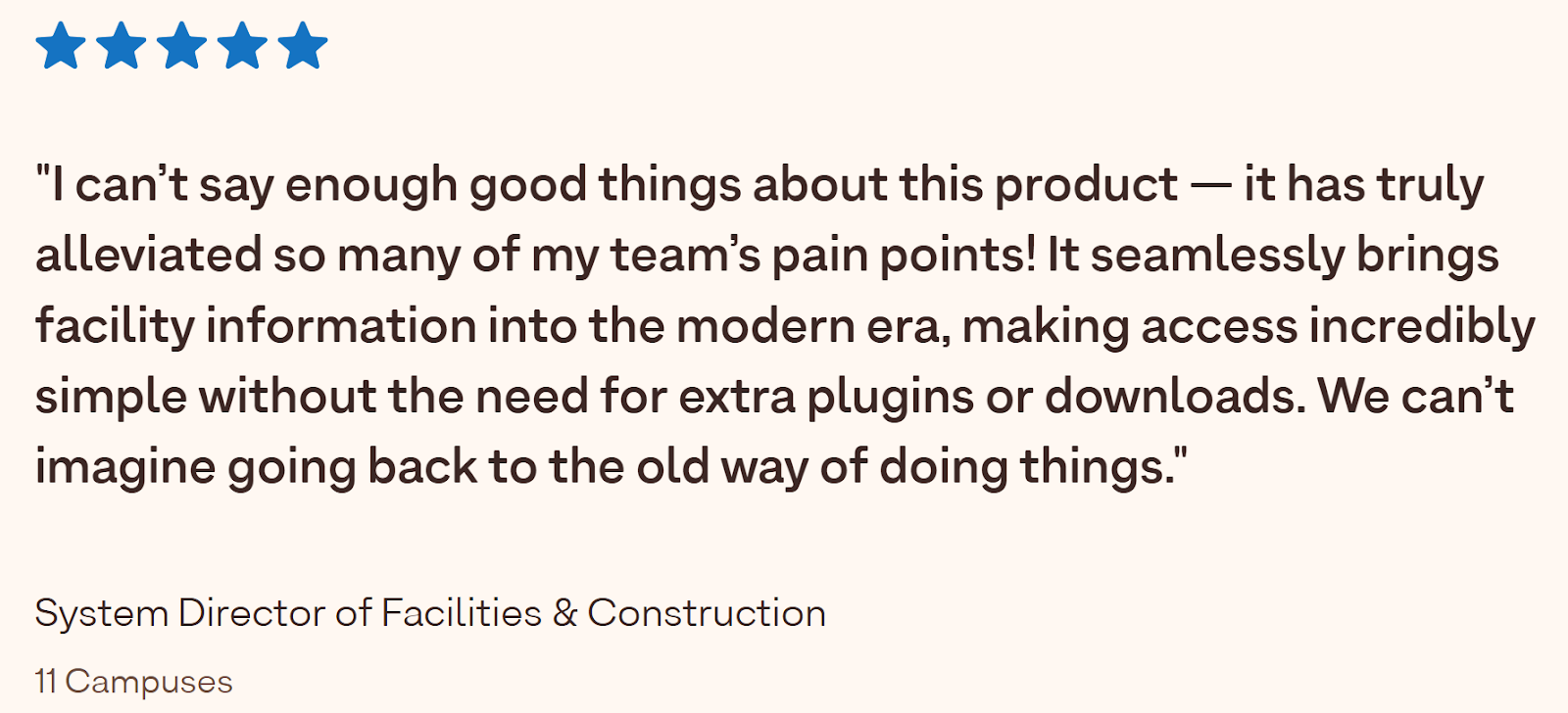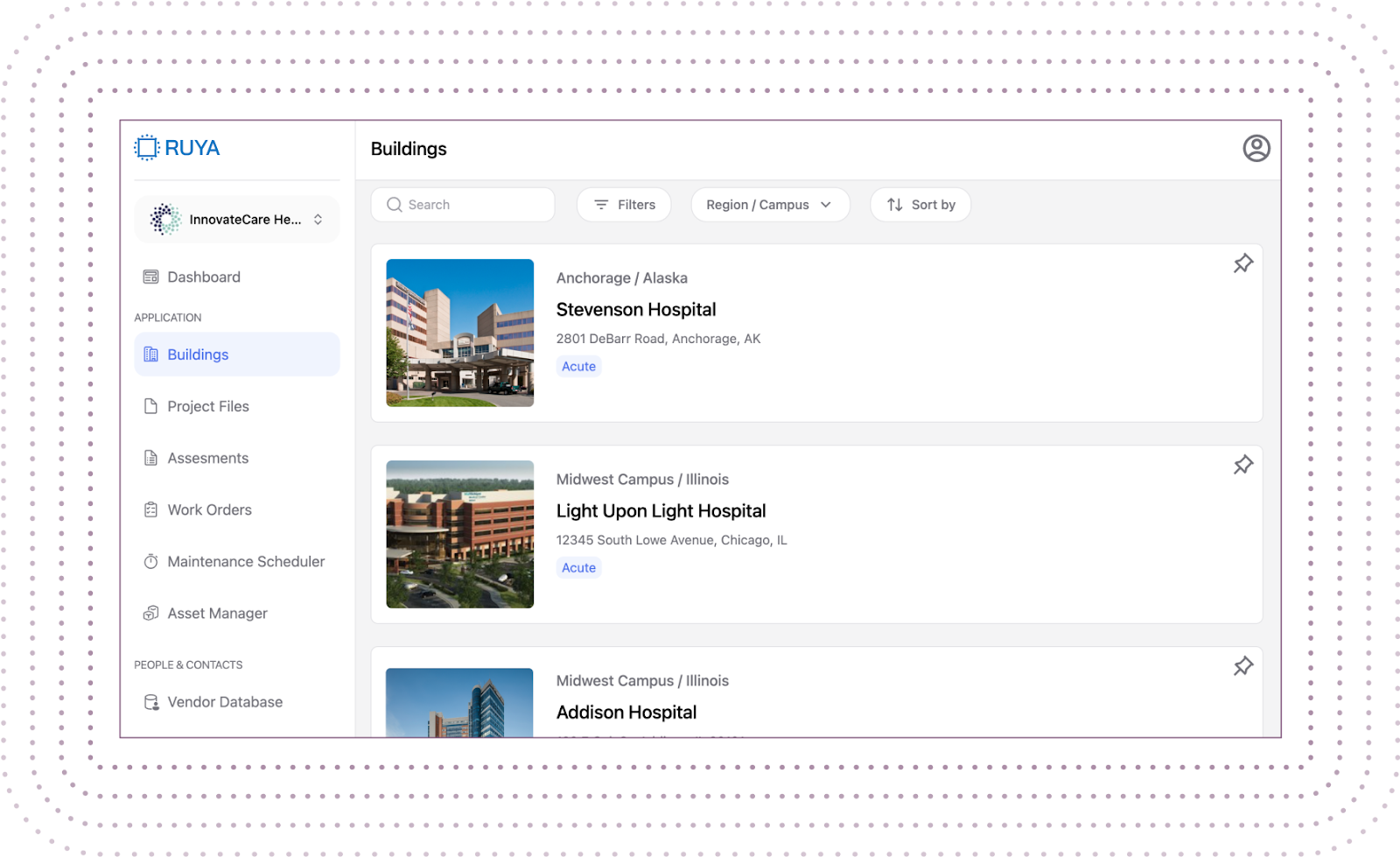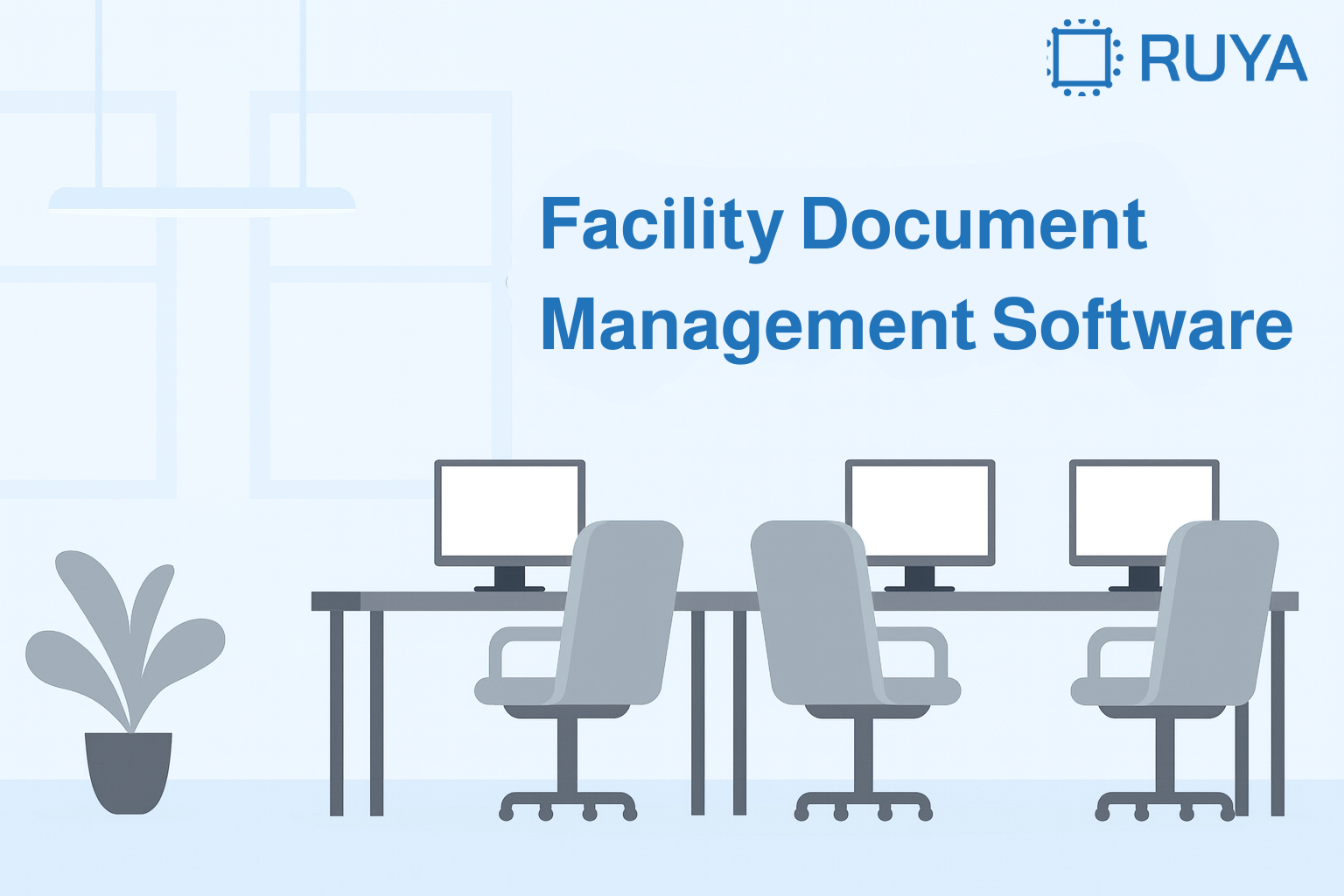What is hospital inventory management? Here’s everything to know

Quick summary
This article explains what hospital inventory management is and how it helps healthcare systems stay efficient, compliant, and ready for audits. You’ll learn about the main types, methods, and best practices for managing hospital supplies, equipment, and infrastructure effectively.
Is your hospital's inventory management keeping up with your facilities’ growth?
Managing a hospital network means overseeing thousands of supplies, medications, and equipment across multiple buildings. When tracking is inconsistent, patient care and compliance are at risk, making inventory control far more than a back-office function.
Manual systems, missing records, and delayed updates can easily disrupt operations and waste resources. Real-time visibility into what’s used, where, and when allows teams to act faster, reduce waste, and maintain compliance.
In this Ruya article, you’ll learn what hospital inventory management is, how it works, and how Ruya helps teams improve accountability, streamline reporting, and stay inspection-ready.
Why listen to us?
Ruya is a facilities management platform. It is purpose-built for hospital facilities, offering mobile-first tools like per-building organization, QR inspection workflows, vendor & asset directories, and smart maintenance triggers. Users report that it replaced scattered spreadsheets and legacy systems with one unified hub, streamlining record-keeping, improving audit readiness, and making field data instantly available.

What is hospital inventory management?
Hospital inventory management is the process of tracking, controlling, and replenishing medical supplies, equipment, infrastructure, and pharmaceuticals within a healthcare facility. It ensures that essential items are available when needed while minimizing waste, preventing stockouts, and supporting consistent patient care.
Hospital inventory management vs supply chain management
Hospital inventory management and supply chain management are closely related but serve different purposes within healthcare operations. Inventory management focuses on what happens inside the facility, while supply chain management covers the entire flow of materials. Key differences include:
- Scope: Inventory management handles storage and usage of items within the hospital, while supply chain management oversees procurement, logistics, and vendor relationships.
- Focus: Inventory management ensures items are stocked and tracked accurately; supply chains manage vendor relationships and stock-keeping units (SKUs) to maintain a steady flow.
- Goal: Inventory management prevents shortages and waste; supply chain management aims to maintain cost-effective, reliable supply networks.
Why hospital inventory management is important
- Ensures continuity of care: Keeps critical supplies, medications, and equipment available when needed.
- Prevents shortages and waste: Helps avoid both stockouts and overstocking by maintaining accurate usage data.
- Supports compliance: Tracks expiration dates, maintenance schedules, and asset conditions to meet standards from CMS, The Joint Commission, and OSHA.
- Improves visibility: Provides real-time insight into inventory levels across departments and campuses.
- Reduces operational costs: Minimizes waste and unnecessary purchasing through better forecasting.
Methods of hospital inventory management
Hospitals use several methods to manage inventory effectively. Each method helps control stock flow, reduce waste, and maintain a continuous supply across departments.
1. By replenishment model (just-in-time/pull vs push/stocked)
- Just-in-time (JIT) or pull systems: Items are replenished only when needed, reducing overstock and freeing up storage space.
- Push or stocked systems: Supplies are pre-delivered based on forecasted demand, ensuring availability but requiring more storage.
- Many hospitals combine both models depending on item urgency, cost, and shelf life.
2. By tracking method (periodic vs perpetual)
- Periodic systems: Stock is manually counted at set intervals, such as weekly or monthly. Suitable for low-cost, non-critical items.
- Perpetual systems: Real-time tracking through software or barcode scanners provides continuous visibility into inventory levels.
- Common valuation techniques include:
- FIFO (First In, First Out) or FEFO (First Expired, First Out): Ensures older or soon-to-expire items are used first.
- LIFO (Last In, First Out): Newest stock is used first, though less common in healthcare.
3. By location of stock (central warehouse vs point of use)
- Central warehouse systems: Store bulk items in one main area, distributing to departments as needed.
- Point of use (POU) systems: Keep essential supplies near care areas to support immediate access and faster turnaround.
4. By supplier ownership/relationship (vendor-managed inventory vs traditional)
- Vendor-managed inventory (VMI): Suppliers track usage and restock items automatically, reducing staff workload.
- Consignment models: Suppliers retain ownership until items are used or billed.
- Traditional models: Hospital staff monitor and reorder supplies directly.
5. By technology/automation (manual/traditional vs digitized/automated)
- Manual systems: Paper logs or spreadsheets require human entry, leading to potential errors.
- Digitized systems: Software and IoT tools automate tracking, alert for shortages, and generate reports for decision-making.
6. By item categorization (ABC analysis, par-level systems)
- ABC analysis: Categorizes items by value and usage frequency; A for high-value, C for low-value.
- Par-level systems: Set minimum and maximum quantities for each item to guide timely replenishment.
Types of hospital inventory management
Hospital inventory management can be classified by the type of materials (inventory) being tracked. They include;
Type 1: Medical supply inventory
This includes everyday consumables used in patient care.
- Items such as gloves, syringes, bandages, IV sets, and disinfectants.
- Managed through par-level systems and just-in-time models for quick replenishment.
- Focuses on minimizing waste and preventing shortages in high-turnover items.
Type 2: Pharmaceutical inventory
Covers all drugs and vaccines used in treatment.
- Includes antibiotics, anesthetics, insulin, painkillers, and vaccines.
- Managed using First Expired, First Out (FEFO) to control expiry-sensitive items.
- Requires secure storage and strict temperature control for compliance and patient safety.
Type 3: Surgical and procedure inventory
Involves specialized materials used in operating rooms or departments.
- Includes surgical instruments, implants, sutures, and sterile kits.
- Managed through case cart and procedure-based systems for readiness.
- Tracking focuses on sterility, availability, and post-use sterilization workflows.
Type 4: Biomedical equipment inventory
Includes diagnostic, monitoring, and therapeutic equipment.
- Covers ventilators, infusion pumps, defibrillators, and imaging machines.
- Managed through asset tracking systems and maintenance scheduling.
- Ensures compliance, safety checks, and performance monitoring of critical devices.
Type 5: Facility and infrastructure inventory
Refers to materials that support hospital operations beyond patient care.
- Includes HVAC systems, electrical panels, elevators, furniture, and building fixtures.
- Managed using computerized maintenance management systems (CMMS) for preventive upkeep.
- Tracks spare parts, maintenance schedules, warranties, and repair histories.
- Vital for maintaining compliance, energy efficiency, and safety standards across large hospital campuses.
- Integrates with broader facility management software to link inventory with inspections and building data.
What is not included in hospital inventory management?
Hospital inventory management does not include non-tangible resources such as staff, digital records, or financial assets. It also excludes patient data, administrative documents, and outsourced services that are not directly related to physical medical supplies or equipment.
Benefits of hospital inventory management
Effective hospital inventory management supports both operational efficiency and cost control across healthcare facilities.
1. Reduces waste and prevents stockouts through accurate tracking
Hospitals manage large volumes of consumables and high-value equipment. Without precise tracking, overstock and expired items become common. Advanced systems give visibility into usage trends and reorder needs, helping teams make informed decisions about restocking.
- Track consumption patterns to predict future demand.
- Use automated alerts to flag low or expiring stock.
- Implement First Expired, First Out (FEFO) to reduce losses.
This control not only cuts waste but also ensures essential supplies are always available, maintaining smooth operations and consistent patient care.
2. Improves cost control by identifying slow-moving or excess items
Effective hospital inventory management helps reduce unnecessary spending by exposing inefficiencies in stock handling. Tracking item turnover shows where money is tied up or wasted.
Finance and supply teams can:
- Flag low-demand items for reduced purchasing.
- Adjust reorder levels to match real usage.
This data-driven adjustment improves budgeting accuracy and supports smarter procurement decisions.
3. Enhances patient safety
By ensuring the right supplies are available and not expired, patient safety is enhanced. Patient outcomes depend on reliable access to sterile, safe, and functional materials. Poor inventory control can lead to expired drugs, missing instruments, or unsafe substitutions.
Strong systems maintain traceability and accountability through:
- Automated expiry tracking for drugs and disposables.
- Barcode verification before use in treatment areas.
- Controlled access to critical items to prevent misuse.
Consistent monitoring ensures clinical teams always work with safe, compliant materials.
4. Facilitates compliance with healthcare regulations and audit requirements
Compliance failures can lead to serious financial and legal consequences. Strong inventory controls help maintain traceable records of procurement, storage, and disposal.
Systems that log every movement, batch numbers, expiry dates, and storage conditions create reliable audit trails. This documentation ensures hospitals meet inspection standards and maintain regulatory certification.
5. Saves staff time with automated monitoring and streamlined ordering
Automation frees clinical and support teams from manual stock checks and paperwork. Real-time dashboards replace time-consuming spreadsheets, allowing faster decisions and fewer errors.
Automated systems:
- Track usage and trigger reorders instantly.
- Centralize approvals and delivery schedules.
By cutting repetitive work, hospitals redirect staff focus toward patient care and operational improvements.
Challenges with hospital inventory management
Hospital inventory management presents key challenges, such as:
- Lack of real-time inventory visibility
- Compliance and regulatory requirements
- Fragmented data across departments
- Manual documentation and human error
- Limited integration with other hospital systems
Best practices for hospital inventory management
To overcome these challenges, follow these best practices:
- Implement a centralized digital system: Use a platform that captures real-time data, links items to departments, and provides full traceability for audits.

- Use automated alerts for expiry, reordering, and low-stock thresholds: Inventory should be checked continuously through automated systems that flag shortages and expiring items before they disrupt care.
- Standardize data entry and integrate all departments under one platform: Centralizing records improves coordination, helps track every item effectively, and ensures compliance.
- Replace manual logs with mobile inspection tools: QR or barcode scanning improves accuracy, reduces delays, and ensures maintenance and restocking are always verified in the field.
- Use analytics to forecast and optimize stock levels: Analyze usage trends to anticipate future demand, balance inventory across sites, and minimize waste while maintaining availability.
Keep your hospital operations running without disruption
Strong inventory management helps hospitals cut waste, avoid shortages, and maintain compliance across departments. The right approach brings visibility to every supply, asset, and facility component, keeping patient care and operations on track. If you need a better way to manage your healthcare facilities, Ruya is a great choice.
Ruya helps healthcare systems organize and monitor facilities by building, combining inspections, vendor data, and maintenance records in one mobile platform. It gives teams real-time access to floor plans, assets, and stock data without relying on scattered spreadsheets. Request a demo.

.svg)


